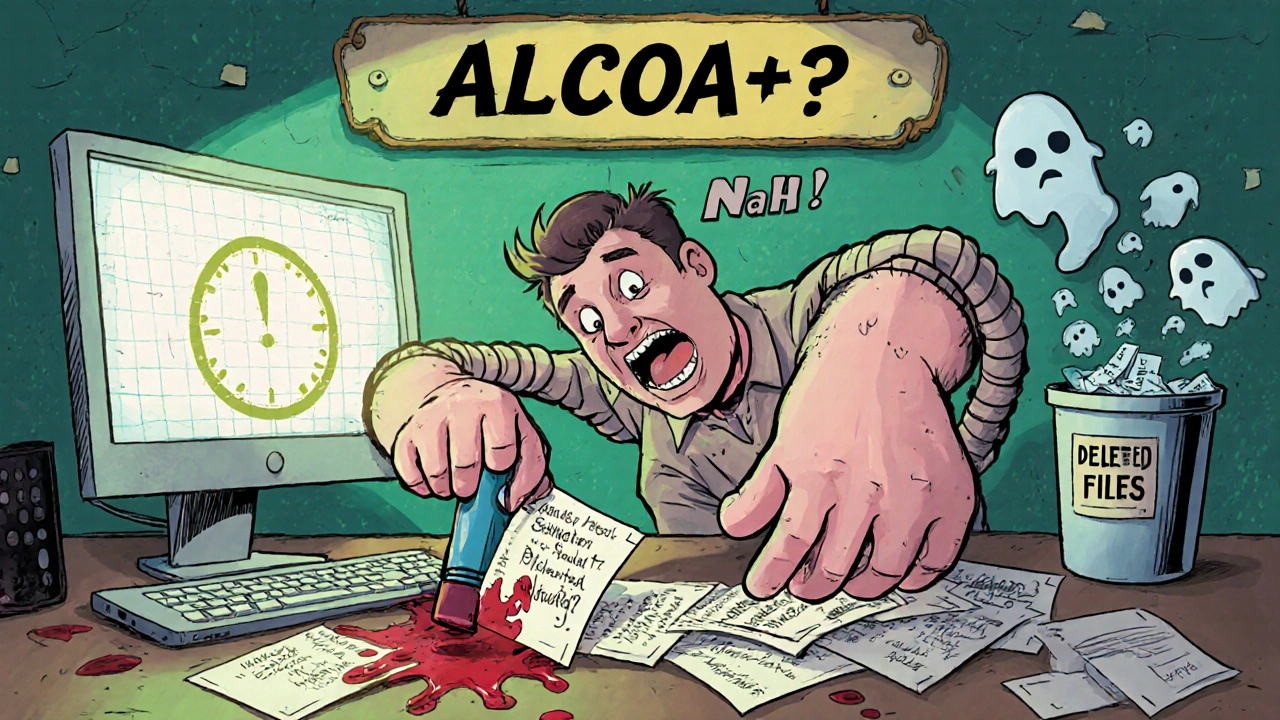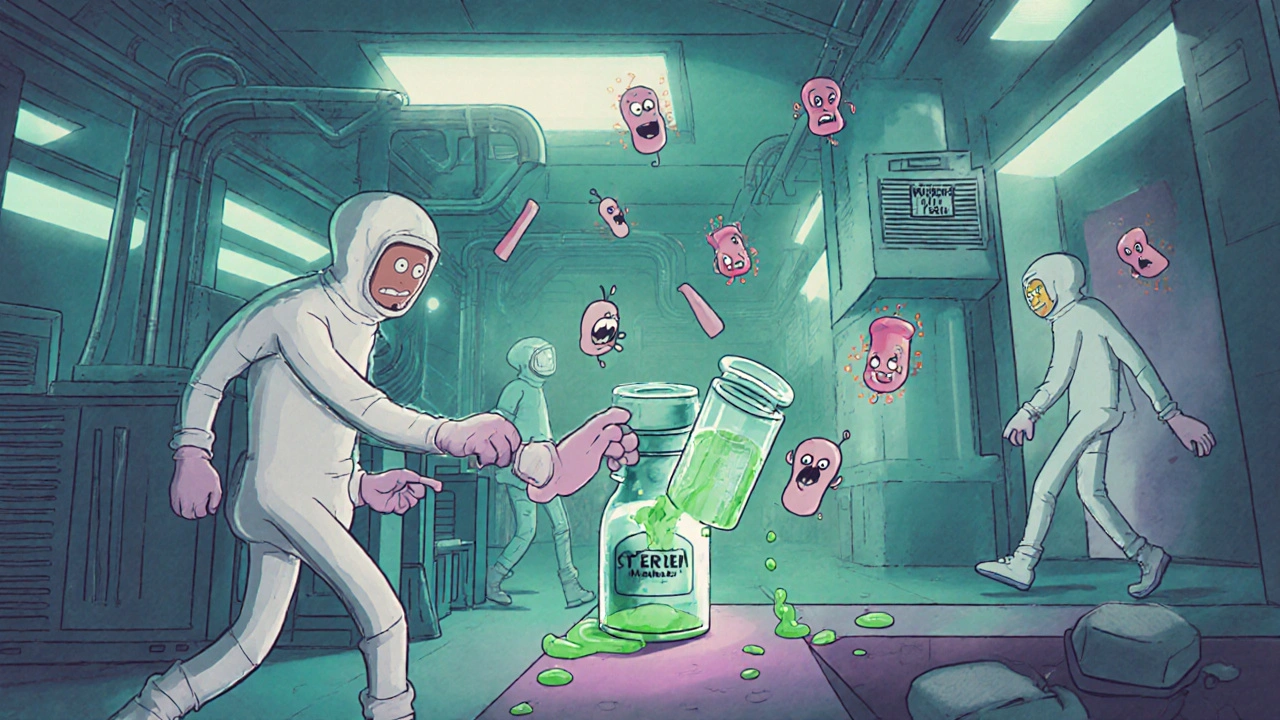When you take a pill, use an inhaler, or apply a cream, you expect it to be safe and effective. But behind every product on the shelf is a factory - often thousands of miles away - where small mistakes can lead to big dangers. In 2025, the FDA issued more warning letters about manufacturing flaws than ever before. These aren’t minor paperwork errors. They’re systemic failures that put patients at risk. The most common problems? Poor sterile handling, fake or missing data, contaminated ingredients, and processes that were never properly tested.
Aseptic Processing Failures Are the #1 Issue
One in every two warning letters from the FDA in 2025 pointed to problems with aseptic processing. That’s the method used to make injectable drugs, eye drops, and other sterile products without letting bacteria or viruses in. If the air isn’t clean, the gloves aren’t sterile, or the workers don’t follow strict protocols, you could be injecting yourself with something deadly.
The FDA found facilities skipping media fill studies - tests that simulate the entire production process using growth media instead of real medicine. These studies prove the environment can stay sterile. One company, Health and Natural Beauty USA Corp., got a warning letter in July 2025 because they hadn’t done a single media fill in over two years. Another, Creative Essences, Inc., was cited for letting workers enter clean rooms without proper gowning. No one was checking if their suits were torn or if they were sneezing near the filling machines.
These aren’t rare mistakes. They’re routine. And the consequences? Contaminated products that cause infections, sepsis, even death. The 2007-2009 heparin crisis - where contaminated blood thinner killed 84 people - still haunts regulators. Today, they’re watching even closer.
Data Integrity: When Records Are Made Up or Erased
If a machine logs a temperature reading, but no one can prove it actually happened, that’s a data integrity failure. And it’s the second most common issue in 2025, showing up in nearly 4 out of 10 warning letters.
FDA inspectors found companies using erasable pens to write batch records, then wiping out mistakes with correction fluid. Others used laminated sheets that could be reused - meaning old data was overwritten, and no one could trace what really happened. Electronic systems were worse. One Chinese manufacturer, Guangxi Yulin Pharmaceutical, had UV-Vis and IR instruments with no audit trails. That means no record of who changed a setting, when, or why. The FDA requires every action to be traceable, time-stamped, and tied to a specific user - the ALCOA+ standard. If you can’t prove it, it didn’t happen.
Some companies thought they could get away with printing out digital logs and taping them to the wall. Others deleted files after inspections. The FDA now uses forensic tools to recover deleted data. If they find it, you’re not just getting a warning - you’re on Import Alert 66-40, and your products are blocked from entering the U.S. until you prove you’ve fixed it.
Contaminated Raw Materials and Poor Supplier Checks
Bad ingredients don’t come from nowhere. They come from suppliers who don’t test properly - or worse, who lie about what they tested.
In 2025, the FDA caught multiple companies using glycerin and sorbitol that contained diethylene glycol (DEG), a toxic chemical linked to kidney failure. One supplier had been selling contaminated material for years. The manufacturer never tested it themselves. They just trusted the certificate of analysis - a piece of paper the supplier wrote themselves.
The FDA now requires companies to verify supplier testing with independent labs. For high-risk materials like glycerin, you must test for DEG and ethylene glycol at levels as low as 0.1% - following USP <1085>. Many firms still skip this. They think, “We’ve never had a problem before.” But one batch of bad glycerin can shut down a whole line - and cost millions in recalls.
One Malaysian facility got cited because they outsourced testing to a lab they didn’t even visit. The FDA showed up and found the lab had never been audited. No contract. No records. Just a phone call and a PDF.

Process Validation: Making Stuff Without Proof It Works
If you’ve never tested your process under real conditions, you’re guessing. And guessing in manufacturing is dangerous.
The FDA found toothpaste manufacturers who had never validated their mixing process. They didn’t know if the active ingredient was evenly distributed. One company made 50,000 tubes before realizing some batches had zero fluoride. Another didn’t validate their analytical method for detecting impurities - meaning they couldn’t tell if their product was safe.
Validation isn’t optional. The FDA’s 2022 guidance says you need three consecutive successful batches with strict in-process controls. Each batch must meet pre-defined acceptance criteria - temperature, pH, particle size, concentration. You can’t just say, “It looks right.” You have to measure it. Document it. Prove it.
Companies in China were most likely to skip this. 28 warning letters in 2025 cited missing analytical method validation. That’s not laziness. It’s negligence.
The Real Problem: Quality Culture
Here’s the truth no one wants to say out loud: Most of these failures aren’t about ignorance. They’re about culture.
Dr. David Lim from Compliance Architects analyzed 127 warning letters and found that 78% of the companies had leadership that prioritized speed over safety. Production targets were met - even if it meant skipping tests, ignoring deviations, or falsifying records. Managers knew what was happening. They just looked the other way.
One Indian facility got cited because they didn’t prepare batch production records for every batch. The manager said, “We don’t have time.” That’s not a technical issue. That’s a cultural one.
The FDA is now looking beyond checklists. They’re asking: Who signs off on deviations? Who gets promoted? Who speaks up when something’s wrong? If the person who reports a problem gets ignored - or punished - you have a broken culture. And no amount of software or training will fix that.
What Happens When You Get Caught
Getting a warning letter isn’t the end. But it’s the beginning of a long, expensive fix.
The FDA requires every company to hire an independent CGMP consultant. That’s not optional. In 92% of 2025 cases, the letter said: “You must bring in an outside expert to audit your system.” Consultants charge $300-$600 per hour. A full remediation can cost $1-3 million - and take 6 to 18 months.
You’ll need to rebuild your data systems with validated audit trails. You’ll need to retrain every employee. You’ll need to revalidate every process. And you’ll have to prove it to the FDA - often with a second inspection.
If you’re on Import Alert 66-40, your products can’t enter the U.S. until you pass a physical exam - meaning FDA agents show up at your door, open every box, and test every batch. That’s not a delay. That’s a shutdown.

Where the Problems Are Happening - And Why
China, India, and Malaysia account for 73% of all 2025 warning letters. But the reasons vary.
Chinese facilities most often fail on analytical method validation - they don’t prove their tests work. Indian facilities struggle with data integrity - they don’t trust their own records. Malaysian companies lack a strong Quality Unit - the team that’s supposed to say “no” when production cuts corners. In India, the national regulator (CDSCO) inspects fewer than 2% of domestic facilities each year. That means companies know they’re unlikely to get caught - until the FDA shows up.
The FDA has ramped up unannounced inspections by 40% in 2025. Two-thirds of those were in Asia. They’re not just checking paperwork anymore. They’re watching how workers move. They’re asking questions. They’re checking if the quality team has real authority.
What’s Changing in 2026
The FDA isn’t slowing down. In fact, they’re getting smarter.
Starting in Q2 2026, the results of their Quality Management Maturity (QMM) program may affect how often you get inspected. If you’ve voluntarily improved your culture and systems, you might get fewer visits. If you’re still cutting corners? You’ll be targeted more.
They’re also watching digital systems. Twelve warning letters in 2025 cited problems with cloud-based quality software - like unsecured logins, no backup controls, or lack of user permissions. If you’re using Google Drive to store batch records, you’re already in violation.
And now, for the first time, the FDA is doing unannounced inspections in the U.S., too. In 2026, they plan to do 1,200 unannounced checks - up from 850 in 2025. No more warning. No more notice. Just show up, walk in, and start looking.
How to Avoid Becoming a Warning Letter Statistic
If you’re in manufacturing, here’s what you need to do right now:
- Test your raw materials. Don’t trust certificates. Do your own checks - especially for glycerin, sorbitol, and solvents.
- Fix your data. Audit trails must be enabled, secure, and uneditable. No erasable pens. No laminated sheets. No deleting files.
- Validate your processes. Three batches. Three times. With full documentation. No shortcuts.
- Empower your Quality Unit. They need to have the authority to stop production. If they’re overruled, fix the culture - not the checklist.
- Train everyone. Not just once. Every six months. With real examples - like the companies that got shut down.
Compliance isn’t a cost. It’s insurance. And right now, the FDA is the only auditor that matters.
What are the most common FDA manufacturing violations in 2025?
The top three are aseptic processing failures (47% of warning letters), data integrity issues (39%), and poor material control (35%). These include skipping sterile tests, falsifying records, and using contaminated ingredients like DEG-laced glycerin.
What happens if the FDA finds a manufacturing deficiency?
You’ll receive a warning letter requiring immediate fixes. You must hire an independent consultant, fix your systems, and prove compliance. If the violation is severe, your products are blocked from the U.S. market until you pass a physical FDA inspection.
Can a company recover after an FDA warning letter?
Yes - but it takes 6 to 18 months and $1-3 million. Companies that fix their quality culture see 63% fewer repeat violations and recover 41% faster than those who only fix paperwork.
Why are Chinese and Indian manufacturers cited more often?
Chinese facilities often lack validated analytical methods, while Indian companies struggle with data integrity due to weak internal oversight. The FDA has increased unannounced inspections in these regions by 40% in 2025, catching more violations than before.
Is the FDA targeting U.S. manufacturers too now?
Yes. In 2026, the FDA plans to conduct 1,200 unannounced inspections in the U.S. - up from 850 in 2025. No more advance notice. If your facility cuts corners, they’ll find out.


Post A Comment